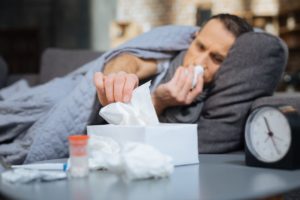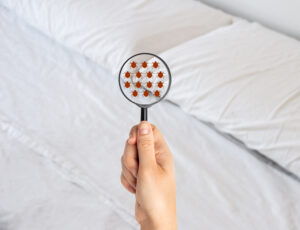Can You Sleep With a Tampon In?
Among people who use menstrual hygiene products, up to 42% report having used tampons in the last month . With such widespread use, many people wonder if they can wear a tampon overnight. While it is generally safe to wear a tampon for four to eight hours, tampon brands do not always offer clear advice about whether or not it is safe to sleep with a tampon in.
We explore expert guidelines for safe tampon use and the potential risk of toxic shock syndrome (TSS). Learn more about the symptoms of TSS, ways to prevent it, as well as several alternatives to tampons.
Is It Safe To Sleep With a Tampon In?
Sleeping with a tampon in may be safe under certain conditions. A tampon is a small, disposable item made of cotton, rayon, or a mixture of both materials that is inserted into the vagina to absorb blood during menstruation. Many people report using tampons while sleeping.
One risk of wearing tampons is a rare condition called toxic shock syndrome (TSS) . TSS can progress rapidly , affect all parts of the body, and can even be fatal if left untreated. The disease has been associated with tampon use since the early 1980s. The U.S. Food & Drug Administration (FDA) regulates tampon testing and labeling in order to reduce the risk of TSS from tampon use.
The safety of sleeping with a tampon in depends on how closely you follow safety guidelines outlined by the FDA. These include changing a tampon within eight hours, only using tampons when you’re on your period and using the lowest possible absorbency tampon.
A tampon’s absorbency refers to how much liquid it can absorb. The FDA requires manufacturers to list absorbency information on tampon packaging, often ranging from light to ultra absorbency. Higher absorbency tampons are associated with an increased risk of developing TSS.

Symptoms of Toxic Shock Syndrome
The FDA recommends that anyone using a tampon contact a health care provider if they notice unexpected or concerning symptoms. TSS symptoms often progress quickly, over the course of a day or two, so seeking medical attention early is important. TSS symptoms may include:
- Fever
- Chills
- Low blood pressure, especially after standing
- Feeling faint
- Skin redness that may resemble a sunburn
- Abdominal pain, vomiting, or diarrhea
- Muscle pain or weakness
- Confusion, tiredness, or seizures
- Headaches, irritability, or hallucinations
Generally, TSS is caused by the Staphylococcus aureus bacteria. However, the infection may also be caused by a type of streptococcus bacteria. Although health care providers may take cultures to look for bacteria when they suspect TSS, positive results are not required for a diagnosis. Instead, TSS is diagnosed based on the presence of rapidly developing symptoms.
Preventing Toxic Shock Syndrome
The rate of TSS has declined over time, at least in part because of FDA regulations. The FDA also provides safety tips to help people use tampons in a way that makes TSS less likely to occur.
To use tampons as safely as possible, whether you plan on being awake or asleep during use, follow these FDA recommendations:
- Read directions: Tampons come with instructions from the manufacturer. Read these carefully to make sure you are using tampons as they are intended to be used.
- Wash your hands: Since TSS is a bacterial infection, washing your hands well before inserting a tampon can help reduce the likelihood that you will spread bacteria.
- Only use tampons during your period: Tampons are only designed to manage your menstrual period. Do not use them at other times.
- Change tampons every four to eight hours: Wearing a tampon for over eight hours is linked with TSS. If you are wearing a tampon to bed, consider setting an alarm to ensure you remove it before eight hours passes.
- Use the lowest needed absorbency: Wearing a high-absorbency tampon makes developing TSS more likely, so the FDA recommends using the lowest absorbency needed for your flow. If a tampon does not become full during eight hours of wear, you might need to switch to a lower absorbency.
- Use tampons once: The FDA has only authorized single-use tampons. Do not try to use a tampon more than once, and do not purchase tampons that claim to be reusable.
- Be aware of TSS symptoms: If TSS does occur, it is important to receive immediate treatment. Seek medical attention if you experience any symptoms of TSS.
Tampon Alternatives
Although toxic shock syndrome is rare, some people may prefer to avoid tampons. Many other types of menstrual hygiene products are available.
Disposable Menstrual Pads
Menstrual pads, also called sanitary napkins, are the most commonly used menstrual hygiene product. Unlike tampons, menstrual pads remain outside of the body and affix to a person’s underwear. Studies suggest the risk of developing TSS is lower when a person uses pads instead of tampons .
Single-use pads are often made of superabsorbent polymer , a material also found in diapers. Pads made of plant fibers, like cotton, hemp, or bamboo, are also available. Regardless of what they are made of, disposable pads are intended to be thrown away after one use.
Disposable pads come in a wide variety of shapes and sizes, ranging from very thin liners to thicker pads intended to be worn overnight. Some also have “wings,” or small, adhesive flaps on each side that attach to the underwear, helping keep the pad in place.
Reusable Menstrual Pads
Reusable pads work similarly to disposable pads in the sense that they sit in the underwear and remain outside of the body. These pads are made of layers of washable fabrics , like cotton, flannel, and fabric blends that include polyester. Rather than attach to the underwear with adhesive, reusable pads stay in place using velcro, snaps, or hook-and-eye closures.
After a reusable menstrual pad has been used, it can be washed, dried, and worn again. Many types of reusable pads are safe to put in the washing machine and dryer. People who prefer reusable menstrual pads often choose them for comfort and because they are thought to be more environmentally friendly.
Menstrual Underwear
Menstrual underwear, also called period underwear, works like a pad that is built into a pair of underwear. So, instead of having to affix a pad to underwear, a person can put on menstrual underwear and have coverage for their period. These underwear are available in both reusable and disposable options. Reusable period underwear n be hand- or machine-washed .
People who are concerned about menstrual blood leaking from a pad into their underwear may be interested in menstrual underwear. Since the entire pair of underwear is absorbent, leaking becomes less of a worry.
Menstrual Cups
A menstrual cup, also called a period cup or vaginal cup, is inserted into the vagina , similar to a tampon. Unlike a tampon, a menstrual cup does not absorb period blood. Instead, the cup collects blood, which must later be emptied. While a tampon should only stay in for up to eight hours, a menstrual cup can be used for up to 12 hours.
Menstrual cups are made of high-quality silicone, rubber, or another medical-grade material. Although cups cost more than other products, they are reusable for up to 10 years and can save a person money over time. Many period cups must be boiled before they are first used and must be cleaned between uses. More research is needed, but menstrual cups may very rarely be associated with TSS. Also, period cups create significantly less waste than tampons and pads.
Anyone with an intrauterine device (IUD), which is a form of inserted birth control, may want to discuss menstrual cups with their doctor before trying one. In some instances, menstrual cups have been reported to remove or change the position of an IUD.
Menstrual Discs
Like menstrual cups, menstrual discs are inserted into the vagina to collect period blood and can be left in the body for up to 12 hours. Menstrual discs may be referred to as period discs or cervical cups, because they sit beneath the opening of the cervix. People can choose between disposable and reusable menstrual discs.
Reusable options may be used for up to 10 years, which means reusable menstrual discs offer significant savings over time and create less waste than tampons and pads. Some people who must change their menstrual product in a public bathroom may prefer disposable discs over reusable discs or cups. Reusable cups and discs require a person to use a sink to clean the item. Some people might find this uncomfortable if they only have access to sinks in a communal or public area.

Still have questions? Ask our community!
Join our Sleep Care Community — a trusted hub of sleep health professionals, product specialists, and people just like you. Whether you need expert sleep advice for your insomnia or you’re searching for the perfect mattress, we’ve got you covered. Get personalized guidance from the experts who know sleep best.
References
10 Sources
-
Branch, F., Woodruff, T. J., Mitro, S. D., & Zota, A. R. (2015). Vaginal douching and racial/ethnic disparities in phthalates exposures among reproductive-aged women: National Health and Nutrition Examination Survey 2001-2004. Environmental Health, 14, 57.
https://pubmed.ncbi.nlm.nih.gov/26174070/ -
Labeling, 21 C.F.R. § 801.430 (1982). Retrieved September 7, 2022, from
https://www.accessdata.fda.gov/scripts/cdrh/cfdocs/cfcfr/CFRSearch.cfm?FR=801.430 -
Chu, V. H. (2022, April 19). Staphylococcal toxic shock syndrome. In S. L. Kaplan, & F. D. Lowy (Eds.). UpToDate. Retrieved September 7, 2022, from
https://www.uptodate.com/contents/staphylococcal-toxic-shock-syndrome -
U.S. Food and Drug Administration. (2020, September 30). The facts on tampons—and how to use them safely. Retrieved September 6, 2022, from
https://www.fda.gov/consumers/consumer-updates/facts-tampons-and-how-use-them-safely -
Schlievert P. M. (2020). Menstrual TSS remains a dangerous threat. EClinicalMedicine, 21, 100316.
https://pubmed.ncbi.nlm.nih.gov/32382715/ -
Foster, J., & Montgomery, P. (2021). A study of environmentally friendly menstrual absorbents in the context of social change for adolescent girls in low- and middle-income countries. International Journal of Environmental Research and Public Health, 18(18), 9766.
https://emedicine.medscape.com/article/1942134-overview#showall -
van Eijk, A. M., Jayasinghe, N., Zulaika, G., Mason, L., Sivakami, M., Unger, H. W., & Phillips-Howard, P. A. (2021). Exploring menstrual products: A systematic review and meta-analysis of reusable menstrual pads for public health internationally. PloS One, 16(9), e0257610.
https://pubmed.ncbi.nlm.nih.gov/34559839/ -
VanLeeuwen, C., & Torondel, B. (2018). Exploring menstrual practices and potential acceptability of reusable menstrual underwear among a Middle Eastern population living in a refugee setting. International Journal of Women’s Health, 10, 349–360.
https://pubmed.ncbi.nlm.nih.gov/30034256/ -
van Eijk, A. M., Zulaika, G., Lenchner, M., Mason, L., Sivakami, M., Nyothach, E., Unger, H., Laserson, K., & Phillips-Howard, P. A. (2019). Menstrual cup use, leakage, acceptability, safety, and availability: A systematic review and meta-analysis. The Lancet. Public Health, 4(8), e376–e393.
https://pubmed.ncbi.nlm.nih.gov/31324419/ -
Munro, A. K., Keep, M., Hunter, E. C., & Hossain, S. Z. (2022). Confidence to manage menstruation among university students in Australia: Evidence from a cross-sectional survey. Women’s Health, 18, 17455065211070666.
https://pubmed.ncbi.nlm.nih.gov/35001743/




























